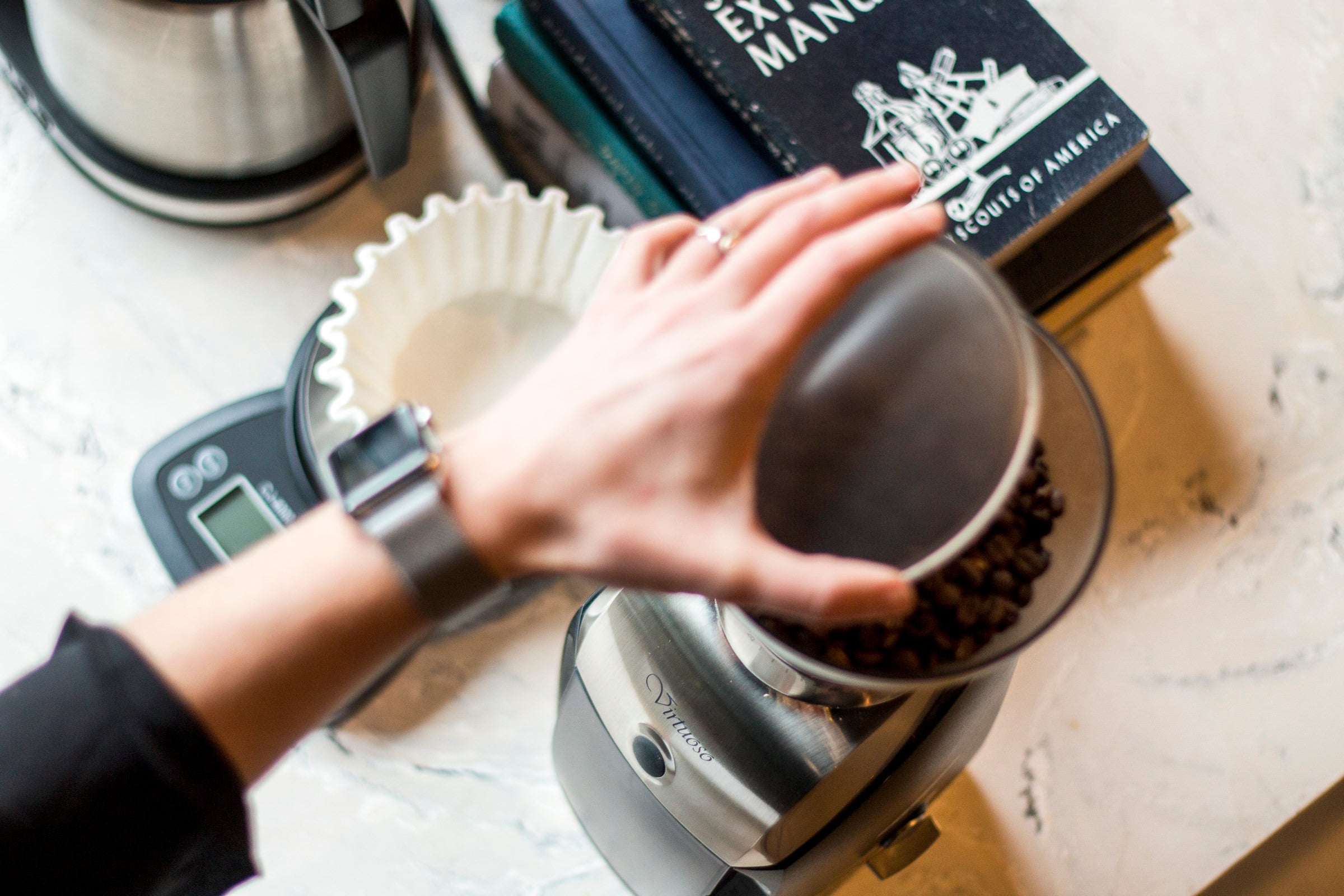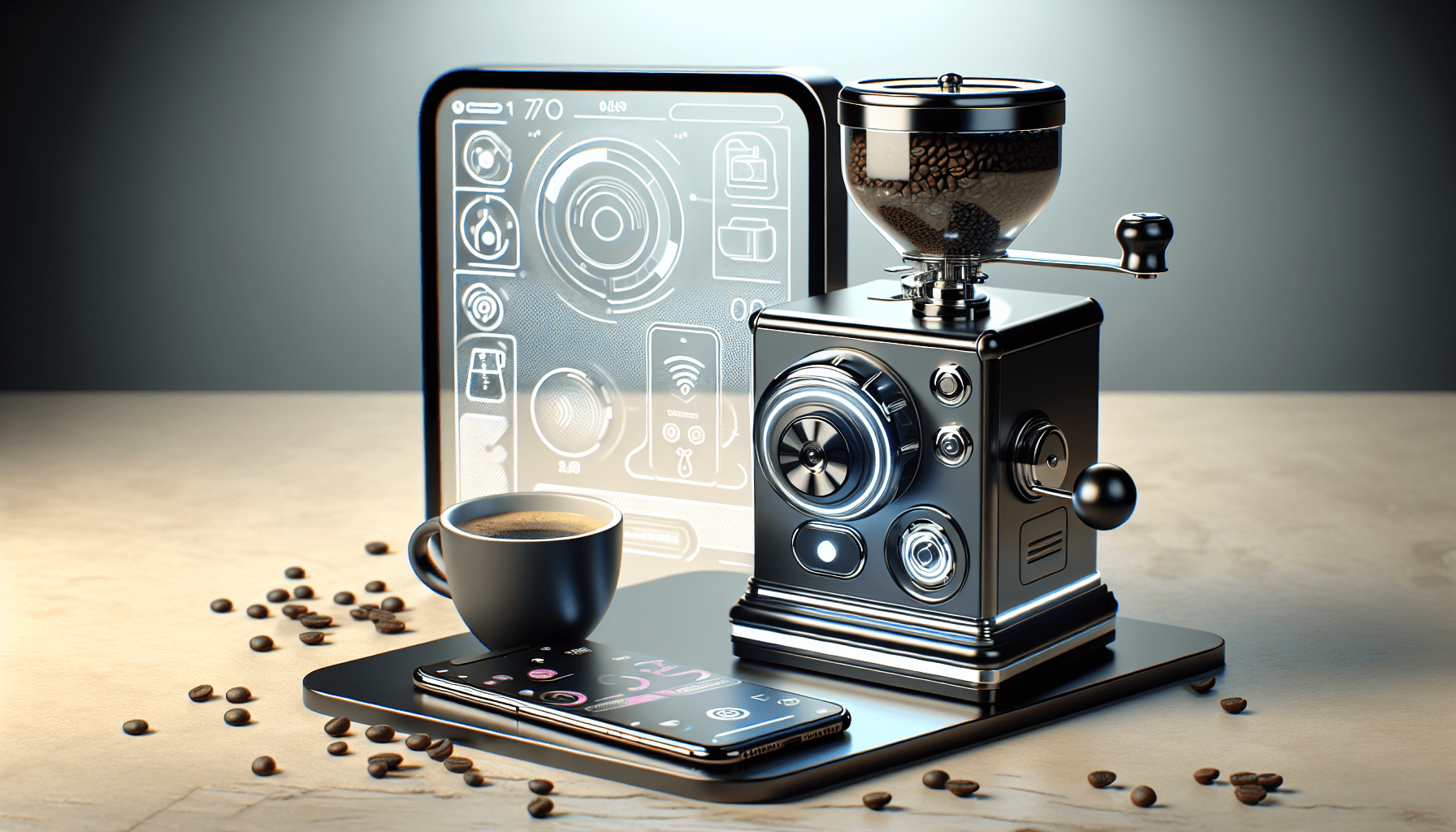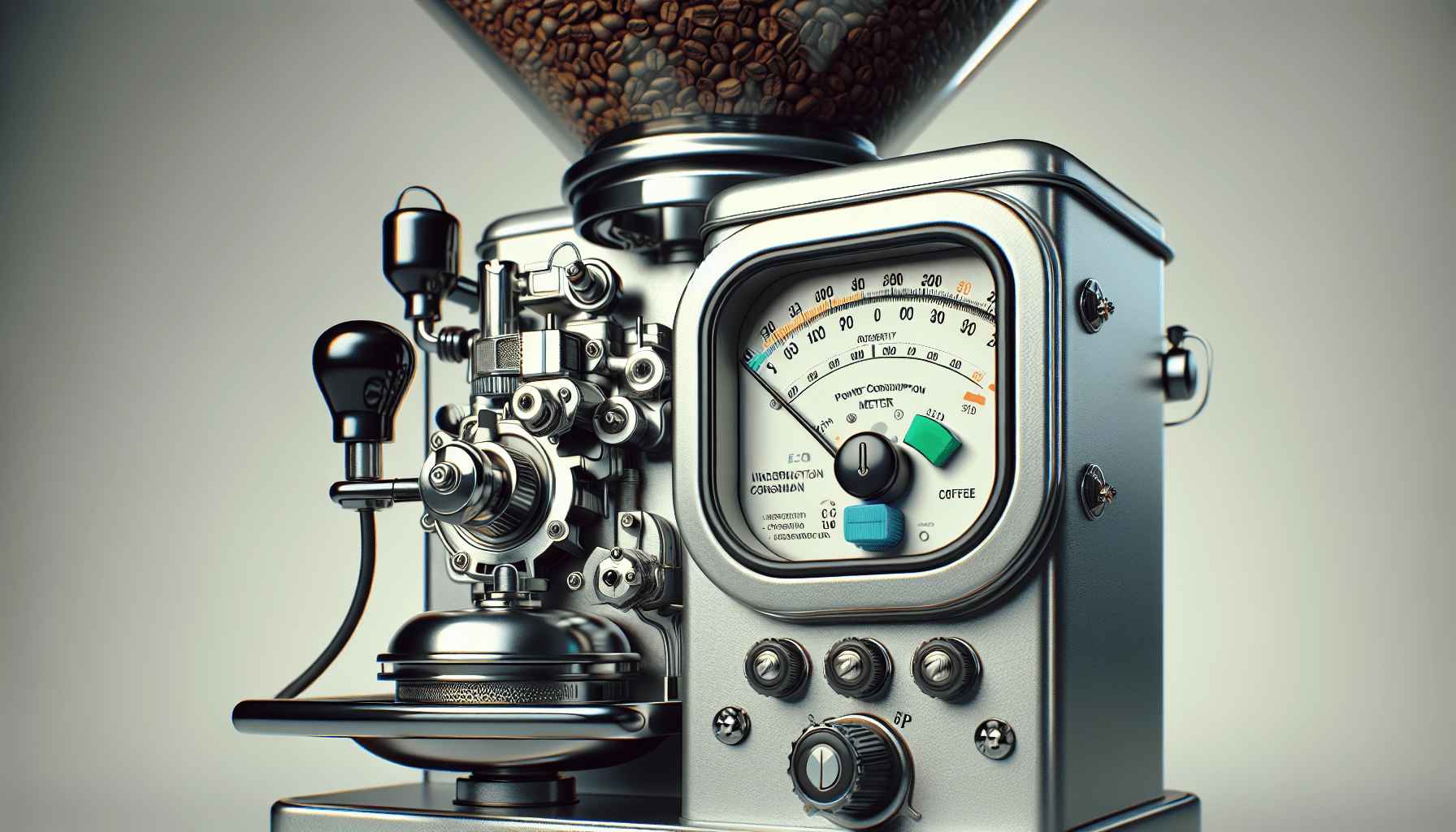Are you tired of waiting endlessly for your coffee to be ground? Well, we have just the article for you! “How Long Does It Take To Grind Coffee Beans With Different Grinder Machines?” explores the varying durations it takes for different grinder machines to process those precious coffee beans into the perfect grind. Whether you’re a busy bee or simply seeking a quick caffeine fix, this article will provide you with invaluable insights on which grinder machine will suit your needs best. Get ready to say goodbye to those frustratingly long waiting times and say hello to a faster coffee brewing experience!
Blade Grinder
Definition and Function
A blade grinder is a type of coffee grinder that uses a spinning blade to chop up the coffee beans. It works similarly to a blender or a food processor. When you turn on the blade grinder, the blade spins rapidly and cuts the coffee beans into smaller pieces.
Grinding Time
The grinding time with a blade grinder is typically shorter compared to other types of grinders. It usually takes about 10-20 seconds to grind the beans to the desired consistency. However, the time can vary depending on factors such as the amount of coffee beans and the desired grind size.
Factors Affecting Grinding Time
Several factors can affect the grinding time with a blade grinder. The main factors include the amount of coffee beans being ground and the desired grind size. If you are grinding a larger quantity of beans, it may take longer for the blade grinder to process them all. Additionally, if you want a finer grind size, it may require more grinding time compared to a coarser grind size.
Burr Grinder
Definition and Function
A burr grinder is a type of coffee grinder that uses two revolving abrasive surfaces, called burrs, to grind the coffee beans. These burrs can be either conical or flat and are typically made of metal or ceramic. The beans are fed into a hopper and then pass between the burrs, which crush and grind the beans to the desired consistency.
Grinding Time
The grinding time with a burr grinder can vary depending on factors such as the grinder’s speed and the desired grind size. On average, it takes around 30-60 seconds to grind a batch of coffee beans with a burr grinder. However, some high-end burr grinders may be faster and more efficient, reducing the grinding time even further.
Factors Affecting Grinding Time
Several factors can affect the grinding time with a burr grinder. The speed of the grinder’s motor plays a significant role in determining how quickly it can grind the beans. A higher motor power can result in faster grinding times. Additionally, the desired grind size can also impact the grinding time. Finer grinds typically take longer compared to coarser grinds.
Manual Hand Grinder
Definition and Function
A manual hand grinder, also known as a hand crank grinder or a hand mill, is a type of coffee grinder that requires manual effort to grind the coffee beans. It consists of a handle, a grinding mechanism, and a receiving chamber for the ground coffee. By rotating the handle, you manually grind the beans to the desired consistency.
Grinding Time
The grinding time with a manual hand grinder is generally longer compared to electric grinders. It can take anywhere from 1-5 minutes to grind a batch of coffee beans, depending on factors such as the grinder’s design, the desired grind size, and the strength and endurance of the person operating the grinder.
Factors Affecting Grinding Time
The main factors that affect the grinding time with a manual hand grinder include the grind size, the physical strength of the person operating the grinder, and the grind size consistency. Finer grind sizes will typically take longer to achieve, while coarser grind sizes may require less time. Additionally, the physical strength and endurance of the user can impact how quickly they can grind the beans.
Electric Burr Grinder
Definition and Function
An electric burr grinder is a type of coffee grinder that uses electricity to power a motor that turns the burrs. It offers the convenience of electric operation combined with the grind consistency of burr grinders. Electric burr grinders are available in both blade and burr variants, with the burr models being more popular among coffee enthusiasts.
Grinding Time
The grinding time with an electric burr grinder can vary depending on factors such as the motor power, the desired grind size, and the quantity of coffee beans being ground. On average, it takes around 20-40 seconds to grind a batch of coffee beans with an electric burr grinder. However, high-end models with more powerful motors can grind beans even faster.
Factors Affecting Grinding Time
Several factors can affect the grinding time with an electric burr grinder. The motor power plays a significant role in determining how quickly the grinder can process the beans. A higher motor power can result in faster grinding times. Additionally, the desired grind size can also impact the grinding time. Finer grinds typically take longer compared to coarser grinds.
Blade Grinder vs. Burr Grinder
Grinding Mechanism
The main difference between blade grinders and burr grinders lies in their grinding mechanism. Blade grinders use a spinning blade to chop up the coffee beans, while burr grinders crush and grind the beans between two abrasive surfaces, known as burrs. This difference in mechanism directly impacts the consistency and quality of the grind.
Consistency of Grind
Burr grinders are known for their ability to consistently produce a more uniform grind compared to blade grinders. The burrs crush the beans between them, resulting in a more even particle size distribution. On the other hand, blade grinders tend to produce a less consistent grind due to the chopping action of the spinning blade.
Grind Size Adjustability
Burr grinders offer greater control and adjustability when it comes to grind size. Most burr grinders have a range of grind size settings that allow you to customize your grind for various brewing methods. In contrast, blade grinders often lack precision settings, making it more challenging to achieve the ideal grind size for specific brewing techniques.
Grinding Speed
Blade grinders are generally faster when it comes to grinding coffee beans compared to burr grinders. This is because the spinning blade quickly chops up the beans, requiring less time to achieve the desired grind consistency. Burr grinders, on the other hand, may take slightly longer to grind the beans due to their crushing and grinding mechanism.
Factors Affecting Grinding Time
Bean Type
The type of coffee beans being used can have an impact on the grinding time. Some beans are denser than others, requiring more time to grind. For example, dark roasted beans are generally less dense and can be ground faster compared to lighter roasted beans.
Roast Level
The roast level of the coffee beans can also affect the grinding time. Beans that are roasted to a darker level tend to be more brittle and easier to grind. In contrast, light and medium roasted beans are denser and may require more grinding time to achieve the desired consistency.
Grinder Type
Different types of grinders have varying grinding mechanisms, which can result in different grinding times. Blade grinders, as mentioned earlier, are generally faster compared to burr grinders due to their chopping action. Manual hand grinders usually take the longest to grind beans, while electric burr grinders can offer faster grinding times depending on their motor power.
Grind Size
The desired grind size has a significant impact on the grinding time. Finer grinds typically require more time to achieve compared to coarser grinds. This is because the grinder needs to work harder to break down the beans into smaller particles for a finer grind.
Motor Power
If you are using an electric grinder, the motor power can affect the grinding time. Grinders with higher motor power can process the beans faster compared to those with lower power. It is important to note that while higher motor power can reduce grinding time, it may also result in higher heat generation, which can affect the flavor of the coffee.
Load Size
The quantity of coffee beans being ground, also known as the load size, can affect the grinding time. Grinding larger quantities of beans will naturally take longer compared to smaller batches. It is important to avoid overloading the grinder, as it can impact the consistency and quality of the grind.
Tips for Efficient Grinding
Use Preheated Grinder
Preheating the grinder can help improve grinding efficiency. Before grinding your coffee beans, run the grinder for a few seconds without any beans in it. This will warm up the grinder’s internal components and reduce the friction, allowing for faster and more efficient grinding.
Avoid Overloading
To ensure efficient grinding, avoid overloading the grinder with too many coffee beans at once. Overloading can strain the grinder’s motor and result in longer grinding times, uneven grinds, or even damage to the grinder. It is best to grind the beans in smaller batches to achieve better results.
Use Proper Grind Size
Using the appropriate grind size for your brewing method can optimize grinding efficiency. Different brewing methods require different grind sizes, and using the correct grind size can ensure uniform extraction and optimal flavor. Refer to the recommendations provided by your coffee equipment manufacturer or coffee experts for guidance on the ideal grind size for your preferred brewing method.
Regular Grinder Maintenance
Routine maintenance of your grinder can contribute to its efficiency and longevity. Clean the grinder regularly to remove any coffee residue that can affect the grinding performance. Additionally, consider sharpening or replacing the burrs (if applicable) and lubricating any moving parts as recommended by the manufacturer. Well-maintained grinders are more likely to provide consistent and efficient grinding results.
Recommended Grinding Times
Espresso
For espresso brewing, a fine grind size is typically desired. Using an electric burr grinder, it may take around 15-25 seconds to achieve the ideal espresso grind consistency. However, it is important to adjust the grinding time based on the specific espresso machine and personal taste preferences.
Fine
A fine grind size is commonly used for brewing methods such as pour-over and AeroPress. With an electric burr grinder, it may take around 10-20 seconds to achieve a fine grind. Again, it is crucial to adjust the grinding time based on the specific brewing equipment and desired flavor profile.
Medium
Medium grind size is suitable for drip coffee makers and some manual brewing methods. With an electric burr grinder, it may take around 20-30 seconds to achieve a medium grind consistency. Adjustments can be made based on the specific brewing equipment and personal taste preferences.
Coarse
Coarse grind size is commonly used for French press and cold brew methods. With an electric burr grinder, it may take around 25-40 seconds to achieve a coarse grind. As always, adjust the grinding time based on the specific brewing equipment and desired strength of the coffee.
Factors to Consider when Choosing a Grinder
Grind Consistency
One of the crucial factors to consider when choosing a grinder is the grind consistency it can achieve. Burr grinders are generally known for their ability to produce a more uniform grind compared to blade grinders. If you are looking to brew coffee with different methods that require specific grind sizes, a grinder with good grind consistency is essential.
Grind Size Options
The number of grind size options available on a grinder can influence its versatility. Burr grinders usually offer a wider range of grind size settings, allowing you to customize the grind size for various brewing methods. Blade grinders, on the other hand, often lack precise settings and may produce a less consistent range of grind sizes.
Ease of Use
Consider the ease of use when choosing a grinder. Look for features such as intuitive controls, clear labeling of grind size settings, and easy cleaning procedures. An easy-to-use grinder can enhance your brewing experience and simplify the grinding process.
Noise Level
Grinding coffee beans can be noisy, especially with electric grinders. If noise is a concern, look for grinders that have noise reduction features or are specifically designed to operate quietly. Manual hand grinders tend to produce less noise compared to electric grinders.
Durability
Investing in a durable grinder is important to ensure its longevity and reliable performance. Look for grinders made from high-quality materials, such as stainless steel or ceramic, that can withstand consistent use over time. It is also helpful to read customer reviews and consider the reputation of the brand when evaluating the durability of a grinder.
Price
Price is always a factor to consider when purchasing a grinder. There is a wide range of grinders available at different price points. It is important to set a budget and consider the features, quality, and durability of the grinder within that budget. Remember, a higher price doesn’t always guarantee the best performance, so prioritize your needs and preferences.
Conclusion
Choosing the right grinder is an important step in achieving a flavorful and enjoyable cup of coffee. Blade grinders offer fast grinding times but may produce inconsistent grinds, while burr grinders provide more consistent results with a wider range of grind sizes. Manual hand grinders require more effort and time but offer a more traditional and hands-on approach to grinding. Electric burr grinders combine convenience and consistency, with various grinding time options depending on the motor power and desired grind size.
Factors such as bean type, roast level, grinder type, grind size, motor power, and load size can influence the grinding time. Understanding these factors and making adjustments accordingly can help you achieve the desired grind consistency and brewing results.
To improve grinding efficiency, consider using a preheated grinder, avoiding overloading, using the proper grind size, and regularly maintaining your grinder. Following recommended grinding times for different brewing methods can also help you achieve optimal flavor extraction.
When choosing a grinder, consider factors such as grind consistency, grind size options, ease of use, noise level, durability, and price. Prioritize your preferences and budget to find a grinder that meets your needs and enhances your coffee brewing experience.



